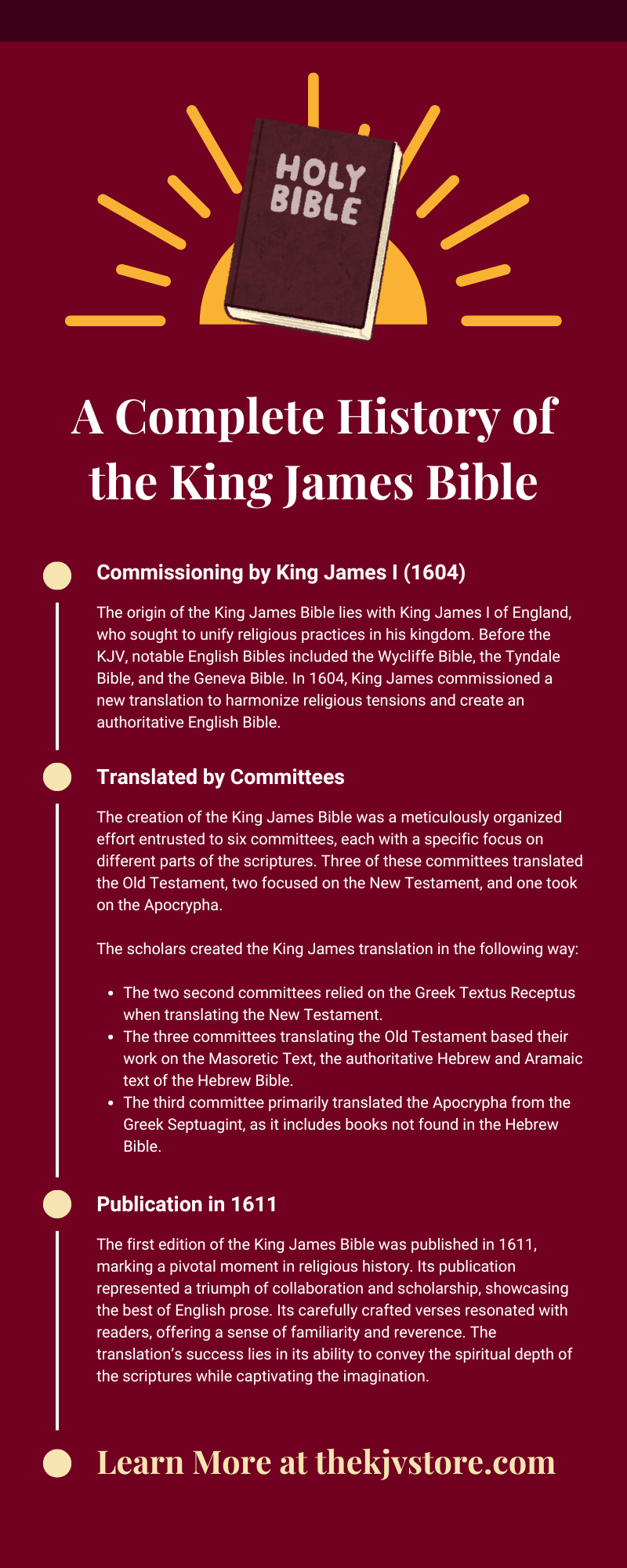A Complete History of the King James Bible

Understanding the history of the King James Bible offers a window into the religious, cultural, and linguistic considerations of Christians over centuries. This translation has profoundly shaped beliefs, language, and literature, becoming a staple for many Christians worldwide. Examine the complete history of the King James Bible to deepen your appreciation of its creation and influence.
Commissioning by King James I (1604)
The origin of the King James Bible lies with King James I of England, who sought to unify religious practices in his kingdom. Before the KJV, notable English Bibles included the Wycliffe Bible, the Tyndale Bible, and the Geneva Bible. In 1604, King James commissioned a new translation to harmonize religious tensions and create an authoritative English Bible.
King James recognized the need for a Bible that reflected the English language’s richness and accessibility for the layperson. The existing translations often led to disputes and divisions, prompting his desire for a single, definitive English version. This decision marked a significant step in religious history, as it sought to bring unity and clarity to Christian worship across England.
Translated by Committees
The creation of the King James Bible was a meticulously organized effort entrusted to six committees, each with a specific focus on different parts of the scriptures. Three of these committees translated the Old Testament, two focused on the New Testament, and one took on the Apocrypha.
The scholars created the King James translation in the following way:
- The two second committees relied on the Greek Textus Receptus when translating the New Testament.
- The three committees translating the Old Testament based their work on the Masoretic Text, the authoritative Hebrew and Aramaic text of the Hebrew Bible.
- The third committee primarily translated the Apocrypha from the Greek Septuagint, as it includes books not found in the Hebrew Bible.
This careful selection of source texts was intended to create a comprehensive and authoritative English Bible, addressing previous inconsistencies. The division of labor ensured that each section received detailed attention from scholars with expertise in the relevant languages and texts. After the committees completed their translations, representatives from each group came together to conduct a comprehensive final review, ensuring consistency and accuracy before the Bible’s publication.
Publication in 1611
The first edition of the King James Bible was published in 1611, marking a pivotal moment in religious history. Its publication represented a triumph of collaboration and scholarship, showcasing the best of English prose. Its carefully crafted verses resonated with readers, offering a sense of familiarity and reverence. The translation’s success lies in its ability to convey the spiritual depth of the scriptures while captivating the imagination.
The 1611 KJV was pivotal to the dissemination of the Bible in the English language. It laid the groundwork for the standardization of the text in later years and contributed to the enduring legacy of the KJV as a foundational religious text. The 1611 original King James Bible is historically significant as it represents the initial efforts to establish a widely accepted English translation, setting a precedent for future versions and revisions.
Typographical Challenges
Two distinct editions of the King James Version (KJV) Bible were published in 1611, colloquially referred to as the “He” and “She” Bibles. These names originated from a textual difference in Ruth 3:15, where one edition reads, “. . . he went into the city,” and the other states, “. . . she went into the city.” Such discrepancies, primarily typographical, highlight the challenges of producing large volumes of text during that era, where manual typesetting and proofreading were prone to errors.
The “King James Version” Name
Initially, the translation, now known as the King James Version, did not have a specific name, and many often referred to it using descriptive phrases, such as “the English Translation made at the beginning of the Reign of King James.” As time progressed, readers referred to it as “King James’s Bible,” with this terminology appearing in various publications by the late 18th and early 19th centuries. By 1814, the term “Authorized Version” started to gain traction despite the text not being formally authorized by any official decree.
In Britain, the 1611 translation is commonly known today as the “Authorized Version,” a term that emerged more prominently in the 19th century. Meanwhile, readers in the United States generally referred to it as the “King James Version,” a phrase that became more widespread in the mid-19th century. The naming conventions reflect the historical context of its publication and the evolving recognition of its significance across different regions.
Revisions and Standardization
The early Authorized Version saw numerous misprints due to disputes over printing privileges, resulting in varied spellings, capitalization, and punctuation. The Cambridge editions of 1629 and 1638 sought to correct these errors by restoring the proper text and incorporating over 200 revisions for a more literal reading.
By the mid-18th century, the numerous variations and misprints in the Authorized Version highlighted the need for standardization. Cambridge University, led by Francis Sawyer Parris, developed the 1760 edition after 20 years of effort. This initiative laid the groundwork for a more uniform text, addressing previous inconsistencies.
The 1769 Oxford edition, edited by Benjamin Blayney, further refined the text, establishing itself as the standard for Oxford and influencing current printings. Blayney built upon Parris’s foundation, incorporating revisions from earlier Cambridge editions and standardizing punctuation and spelling, resulting in thousands of minor changes.
Influence on Religious Practice
The King James Bible has profoundly shaped religious practices and beliefs within Protestant denominations. Its use in public worship, private devotion, and theological study has fostered a deep connection between believers and the scriptures. The translation’s eloquence and accessibility have made it a cherished resource for spiritual growth and reflection.
The King James Bible became the primary text for liturgical readings and sermons within the Church of England. Its melodic prose and vivid imagery enriched communal worship, enhancing the spiritual experience for congregants. Its teachings have shaped theological doctrines and informed ethical decision-making, providing a foundation for moral guidance.
Global Dissemination and Influence
The expansion of the British Empire facilitated the global dissemination of the King James Bible, spreading its influence across continents. Missionaries and settlers carried the translation to new territories, introducing its teachings to diverse cultures and languages.
The dissemination of the King James Bible also sparked interest in translating the scriptures into local languages, promoting literacy and education. This movement empowered communities to engage with the Bible in their mother tongues, fostering a deeper connection to its teachings. The legacy of the King James Bible is a testament to its role as a catalyst for spiritual and intellectual growth.
The complete history of the King James Bible reflects a journey of faith, language, and scholarship with the aim of uniting believers under a shared, accurate text. Originating from King James I’s vision, it bridged divides and established a comprehensive English translation that many have revered for centuries. Through successive revisions, it achieved a standardized form, enhancing its impact on religious, educational, and cultural practices worldwide. Today, it continues shaping theological discourse and promoting a broader understanding of Scripture.

